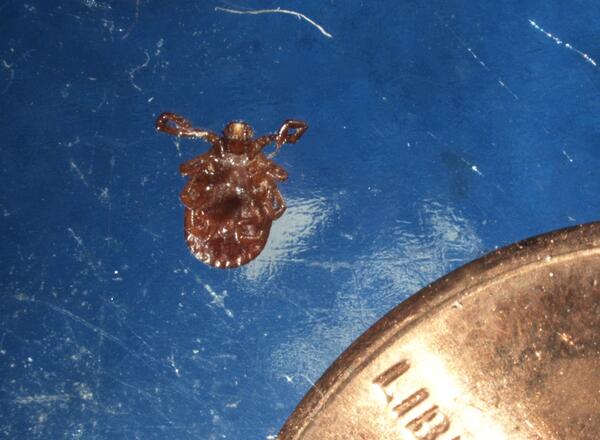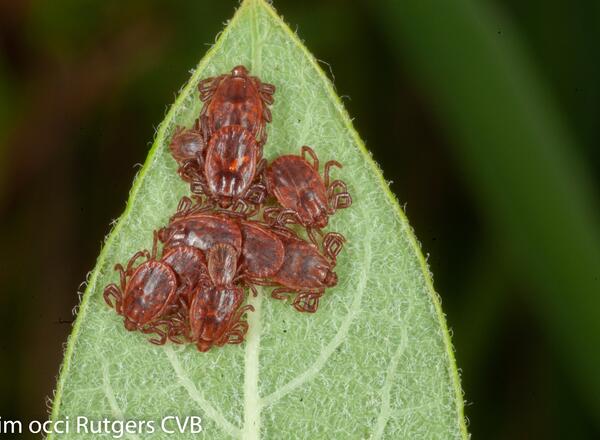The Asian longhorned tick (Haemaphysalis longicornis) is an invasive pest that was first found in west central Illinois in April 2024. These small ticks can be found on people, pets, livestock, and wildlife in large quantities, and bites from these ticks can make people and animals ill. It is a pest of concern for livestock because severe infestations can be fatal.
ALT can infest a variety of mammals. So far Asian longhorned ticks have been found on numerous domesticated and wildlife species hosts including sheep, goats, dogs, cats, horses, cattle, chickens, black bears, grey squirrels, red and grey foxes, groundhogs, striped skunks, white-tailed deer, elk, opossums, raccoons, Canada geese, barred owls, great horned owls, brown boobies, mice, blue jays, and red-tailed hawks
Heavy ALHT infestations have been reported on cattle and white-tailed deer, and livestock and deer are thought to be their primary hosts. In its native range, it vectors several diseases for animals and humans. ALHT in the U.S. does not currently carry or vector any pathogens. ALHT has been shown to carry Rocky Mountain Spotted Fever under laboratory conditions, but this has not been found in the field.
ALHT are unique among many other ticks because they can reproduce without a male. A female tick can lay up to 2,000 eggs without a male, meaning that one female can create a new population,
History
ALHT is a recent invader of the U.S. It was confirmed in the U.S. in 2017 but has likely been here since 2010. It was first found in west central Illinois in April 2024. It has also been found in Kentucky, Indiana, Missouri, and Tennessee.


Asian longhorned tick regulation
There are currently no regulations in place.
How to identify the Asian longhorned tick
ALHT is a very small light brown tick. The adults are about the size of a sesame seed before feeding and about the size of a pea after a blood meal. They are difficult to detect because they are so small. Female ticks lay eggs in spring and early summer and when the larvae hatch, they climb plants and wait for a suitable host. They are host-seeking through their larval and nymphal stages throughout the summer.
Asian longhorned ticks favor low-lying swampy areas, wooded areas, and taller grasses. Large numbers of ticks can be found in areas with established populations where these areas converge.
For both livestock and humans, tick checks are crucial for prevention of tick infestations and possible disease spread. There are pasture and lawn control measures that can reduce tick-bite risk.
Weed control, low grass height, and general sanitation are good cultural control practices to prevent tick-bite risk. There are labeled insecticides for ALHT control in the environment as well as personal protective clothing that can be used to prevent tick bites on humans.
Asian longhorned tick appears to be susceptible to most of the chemical products commonly used to treat other species of ticks on cattle. If cattle continue to graze pastures that are heavily infested, they may become reinfected as drug levels provided by treatment drop off. The length of time that any of these products will keep cattle from becoming reinfected is not currently known but will likely vary based on the product and the number of ticks in the pasture. Consult your herd veterinarian to develop a plan for ectoparasite prevention.
Mow Pastures: Mowing pastures will help keep tick numbers lower than not mowing. Preliminary data suggests that the combination of mowing and chemical products can lessen tick burden on livestock.
Wooded areas: If Asian longhorned tick is found in wooded areas, livestock should not roam the area until late fall when temperatures have fallen and ticks become inactive.
University of Illinois Extension is working to survey the area where invasive Asian longhorned ticks were first identified to get a better understanding of the population size, risks, and to help prevent further spread. Residents in Morgan County and the surrounding west central Illinois area are encouraged to collect and submit ticks by mail or at their local county Extension office
Tick Removal
- Pets and Livestock: Pull ticks gently and place them in a collection container.
- Human skin: Use a tweezer to grasp the tick as close to the skin as possible. Then apply gentle pulling pressure to remove the tick. After removing the tick, wash your hands with soap and water and the site of the tick attachment with isopropyl alcohol.
Containers, Labeling, and Storage
A variety of containers that seal can be used to store collected ticks such as a sealed plastic bag, an empty condiment jar, or a pill bottle. The ticks should be placed in isopropyl or rubbing alcohol in the sealable container. Containers of ticks and alcohol can be left on the counter out of sunlight. Periodically check the level of alcohol to prevent drying out. If not using alcohol, place the container in the freezer until submission.
Label each container with the date and location of collection. If the ticks are removed from pets, please indicate whether the pets are treated with flea/tick products and the specific product. Be sure to note if travel out of state had occurred in the previous three weeks and destination(s).
In situations where there are many small ticks called nymphs, sometimes referred to as turkey mites, use a lint roller to remove the ticks from clothing. Remove the sheet and place it on a flat surface with the sticky side up. Pull off another sheet and put the smooth side down on the first sheet. Do not put both sticky sides together. Then pull off a third sheet and lay the sticky side against the sticky side of the second sheet. Place the sheets in a sealable bag and label them appropriately. Do not collect ticks with packing or transparent tape
How to Submit Ticks
Take collection containers of ticks with rubbing alcohol to your local county Extension office. Find your local office at go.illinois.edu/ExtensionOffice. Offices will have a submission form that can be filled out to gather information for researchers. If you want to know the tick species you submitted, please provide contact information.
Ticks in sealable plastic bags without alcohol can be mailed to:
Teresa Steckler
354 State HWY 145 N
Simpson, IL 62985
More resources
- CDC, What you need to know about Asian longhorned ticks – A new tick in the United States
- Current U.S. distribution of ALHT
- PennState Extension, Asian Longhorned Tick, Haemaphysalis longicornis
- New York State Integrated Pest Management
References
- Failure of the Asian longhorned tick, Haemaphysalis longicornis, to serve as an experimental vector of the Lyme disease spirochete, Borrelia burgdorferi sensu stricto
- First glimpse into the origin and spread of the Asian longhorned tick, Haemaphysalis longicornis, in the United States
- A pictorial key to differentiate the recently detected exotic Haemaphysalis longicornis Neumann, 1901 (Acari, Ixodidae) from native congeners in North America
- The Ability of the Invasive Asian Longhorned Tick Haemaphysalis longicornis (Acari: Ixodidae) to Acquire and Transmit Rickettsia rickettsii (Rickettsiales: Rickettsiaceae), the Agent of Rocky Mountain Spotted Fever, Under Laboratory Conditions